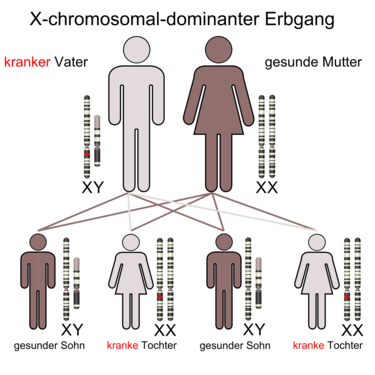X-linked inheritance
An X-linked inheritance is an inheritance in which the trait-bearing gene is located on the X chromosome . Because in many animal species and in humans the male individuals (besides the Y chromosome ) only have one X chromosome, they are always homozygous with regard to genes on the X chromosome, more precisely hemizygous . That is why a trait encoded on the X chromosome always appears in the phenotype , even if it is a recessive trait. Which individuals are carriers and the probabilities of whether and how many carriers of traits would result from a connection with certain partners can be determined by family tree analysis.
Example for an animal species with X-linked inheritance of a coat color

In domestic cats, there is a recessive allele for orange fur on the X chromosome, which is why orange specimens are mostly male cats. Homozygous females can also be orange. Heterozygous females have black pigment in their fur, but are conductors of the facility for orange. Right picture: female with black tendency as a carrier of the recessive gonosomal hereditary disposition for orange with puppies from an orange male: Depending on which allele a puppy received from the mother, (on average ) 50% can only produce pheomelanin and are orange. 50% can also produce eumelanin , recognizable by the black or gray stripes.
In male puppies (XY) the decisive factor for the coat color is which of the two X chromosomes they got from the mother, because the Y chromosome from the father does not contain a corresponding allele. In the female puppies (XX) it is also crucial which X chromosome they got from the mother, because the disposition for orange is recessive, so that only homozygous orange become.
X-linked hereditary diseases in humans
The rules of X-linked inheritance become relevant, for example, in the case of hereditary diseases that are caused by a mutated allele of an X-linked gene. With the more frequent recessive X-linked inheritance, women only develop the disease if they have the trait on both X-chromosomes. If they are heterozygous , there is a 50% probability that they pass the gene on to their sons, who then become ill. 50% of the daughters are also latent carriers without being sick themselves. Examples of such hereditary diseases are hemophilia and red-green poor eyesight .
In the case of dominant alleles , the mothers themselves are sick and pass 50% of the characteristic on to sons and daughters who both also get sick. If the father carries the allele, he is always sick in this case too. He passes the allele on to all daughters (never to sons) who also fall ill with a dominant inheritance and, in turn, become carriers with a recessive inheritance. Examples of such diseases are Rett syndrome , Bloch-Sulzberger syndrome and most cases of Alport syndrome .




